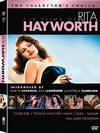





Teresa Wright
Biography | Filmography | Awards | Articles | Remembering | Bibliography | Gallery | News | Downloads | Links | Image Credits | THE LITTLE FOXES | MRS. MINIVER | SHADOW OF A DOUBT | THE PRIDE OF THE YANKEES | THE BEST YEARS OF OUR LIVES
| Interview: |
Excerpt 7 |
Reminiscences of Teresa WrightNew York, June 1959On Sam Wood and William Cameron MenziesQ: Sam Wood seems the prototype of the Hollywood director.Yes, he was. It was quite a surprise and shock to me when I first worked for him in "Pride of the Yankees." He had working with him then a man by the names of William Cameron Menzies, who was a set director or art director. Bill Menzies used to draw a sketch for every scene -- it was beautiful, it was well conceived. Bill had a marvelous motion picture eye. In his mind's eye he saw what would be the right finished product on the screen. These sketches were a great help to Sam Wood, and therefore I think the quality of Wood's pictures was far better when he worked with Bill Menzies. He began on "Good-bye, Mr. Chips" and I believe he ended with "For Whom the Bell Tolls." But the difference between working with him on "Pride of the Yankees," and then with him several years later without Bill Menzies on a thing called . . . [transcript illegible; probably "Casanova Brown" (the only other film she made with Wood); more illegible dialogue] . . . is a dancer who keeps appearing on TV all the time.) I thought that was one of the funniest scripts I ever read in my life, but the picture was just miserable. For instance, one of the things where I feel it was hurt was, that in a comedy scene involving a few people, instead of the Wyler technique of being able to show a whole room -- a thing is funny itself, but it's much funnier when you see the people reacting to it at the same time, and the contrast -- well, what Sam did in this funny scene was to play the whole scene in a close-up on the same person. They he did the scene all over again, close-up on another person. With perhaps seven people in a room, after you've done this seven times in a close-up, seven times in a medium shot, seven times in a long-shot -- maybe twenty-five takes for each shot that you want -- any spontaneity that was there is certainly gone. Besides the fact that all the people see on the scene is a close-up here and a close-up there, and they don't have any idea of the impact of the whole scene, which is a group of people reacting to a funny situation. I was really disappointed, and I realized how much he needed that man, Bill Menzies. The humor goes right out. © 1959 Columbia University and the Oral History Research Office |
|
Return to the Interview Excerpts
Table of Contents. |
| Now in Print! |
|---|
| Now on DVD! |
|---|
Buy Videos & DVDs |
|
Buy Movie Posters |
|
Buy Movie Posters |
|
Classic
Movie Merchandise |
|
![]() Printer-friendly version.
Printer-friendly version.
![]() Return
to the top.
Return
to the top.
Last updated:
March 10, 2011.
Reel Classics is a registered trademark of Reel Classics, L.L.C.
© 1997-2011 Reel Classics, L.L.C. All rights reserved. No
copyright is claimed on non-original or licensed material.
Terms of
Use.









